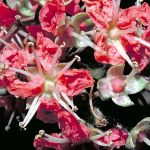| Common Name: |
Mignonette Tree |
| Other Names: |
Henna, Egyptian privet |
| Botanical Name: |
Lawsonia inermis syn. L. alba |
| Genus: |
Lawsonia |
| Family: |
Lythraceae |
| Native Location: |
N Africa to SW Asia |
| Cultivation: |
Well-drained, sandy soil in sun. Remove dead wood and trim to shape in late spring. Trim hedges in early summer. |
| Propagation: |
By seed sown in spring at 18-21°C (64-70°F); by softwood cuttings in spring; by hardwood cuttings in autumn. |
| Harvest: |
Young leafy shoots, 20-25cm (8-10in) long, are picked during the growing season and dried for use in powders. Flowers are gathered in early morning and distilled for oil. Bark is stripped from cut branches as required. |
| Height: |
3-6m (10-20ft) |
| Width: |
2-4m (6-12ft) |
| Hardiness: |
Z9 |
| Parts Used: |
Leaves, bark, flowers, oil. |
| Properties: |
An astringent, aromatic herb that controls bleeding and is antiseptic and anti-bacterial. Regarded as an alterative and nerve tonic in Ayurvedic medicine. Flowers are insecticidal. |
| Medicinal Uses: |
Internally for diarrhea, amebic dysentery (Leaves); liver problems (bark); Externally for skin diseases (including leprosy), sore throat, wounds, burns, ulcers, acne, boils, and herpes. An ingredient of eye lotions and anti-rheumatic liniments in the Middle East. |
| Economic Uses: |
Dried, powdered leaves are used for dyeing hair, feet, nails, and hands,. Lilac-scented oil is used in perfumery. |
| Bibliography: |
The Encylopedia of Herbs by Deni Bown Copyright © 1995, 2001 Dorling Kindersley Limited pg 257 |

